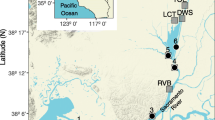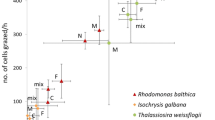Abstract
Acartia tonsa Dana is a dominant copepod in coastal waters and is therefore an important link in the food web between microplankton and higher trophic levels. RNA:DNA ratios have been used to describe growth and nutritional condition of field-collected copepods and to show strong correlation between RNA:DNA ratios and group egg production (EP). A method was developed using a sensitive, nucleic acid-specific fluorescent dye, and automated microplate fluorometer to measure DNA, RNA, and the RNA:DNA ratio of individual A. tonsa. DNA, RNA, and RNA:DNA ratios and EP were all significantly higher in copepods fed Thalassiosira sp. compared to starved copepods. There was a general trend toward an increase in RNA:DNA ratios with increase in EP, but due to the high degree of variation in both RNA:DNA ratios and EP among individual copepods there was no significant correlation between RNA:DNA ratios and EP. Significant differences in RNA:DNA ratios between fed (7.2) and starved (3.3) copepods were found after 2 days. This assay may be applied to other species of copepods sampled in the field to provide an index of the health of planktonic food webs.




Similar content being viewed by others
References
Bentle LA, Dutta S, Metcoff J (1981) The sequential enzymatic determination of DNA and RNA. Anal Biochem 116:5–16
Bersano JGF (2000) Field and laboratory studies on the effect of the Texas brown tide alga Aureoumbra lagunensis on copepods Acartia tonsa. Ph.D dissertation, Texas A&M University
Bosch TC, David CN (1984) Growth regulation in Hydra: relationship between epithelial cell cycle length and growth rate. Dev Biol 104:161–171
Bulow FJ (1987) RNA-DNA ratios as indicators of growth in fish: a review. In: Summerfelt RC, Hall GC (eds) The age and growth of fish. The Iowa State University Press, Ames, Iowa, pp 45–64
Buskey EJ (1993) Annual pattern of micro and mesozooplankton abundance and biomass in a subtropical estuary. J Plankton Res 15:907–924
Calbet A, Alcaraz M (1996) Effects of constant and fluctuating food supply on egg production rates of Acartia grani (Copepoda: Calanoida). Mar Ecol Prog Ser 140:33–39
Caldarone EM, Clemmesen CM, Berdalet E, Miller TJ, Folkvord A, Holt GJ, Olivar MP, Suthers IM (2006) Intercalibration of four spectrofluorometric protocols for measuring RNA/DNA ratios in larval and juvenile fish. Limnol Oceanogr Method 4:153–163
Conover RJ (1956) Oceanography of Long Island Sound, 1952–1954 IV. Biology of Acartia clausi and A. tonsa. Bull Bingham Oceanogr Collect 15:156–233
Durbin EG, Durbin AG, Smayda TJ, Verity PG (1983) Food limitation of production by adult Acartia tonsa in Narragansett Bay, Rhode Island. Limnol Oceanogr 28:1199–1213
Escribano R, McLaren IA, Breteler WCMK (1992) Innate and acquired variation of nuclear DNA contents of marine copepods. Genome 35:602–610
Garlick PJ, Burk TL, Swick RW (1976) Protein synthesis and RNA in tissue of the pig. Am J Physiol 230:1108–1112
Gorokhova E (2003) Relationship between nucleic acid levels and egg production rates in Acartia bifilosa: implications for growth assessment of copepods in situ. Mar Ecol Prog Ser 262:163–172
Hazzard SE, Kleppel GS (2003) Egg production of the copepod Acartia tonsa in Florida Bay: role of fatty acids in the nutritional composition of the food environment. Mar Ecol Prog Ser 252:199–206
Jones LJ, Yue ST, Cheung C-Y, Singer VL (1998) RNA quantitation by fluorescence-based solution assay: RiboGreen reagent characterization. Anal Biochem 265:368–374
Kimmerer WJ, MacKinnon AD (1987) Growth, mortality and secondary production of the copepod Acartia tranteri in Westernport Bay, Australia. Limnol Oceanogr 32:177–189
McLaren IA, Marcogliese DJ (1983) Similar nucleus numbers among copepods. Can J Zool 61:721–724
McManus GB, Foster CA (1998) Seasonal and fine-scale spatial variations in egg production and triacylglycerol content of copepod Acartia tonsa in a river-dominated estuary and its coastal plume. J Plankton Res 20:767–785
Nakata K, Nakano H, Kikuchi H (1994) Relationship between egg productivity and RNA/DNA ratio in Paracalanus sp. in the frontal waters of the Kuroshio. Mar Biol 119:591–596
Ohno A, Takahashi T, Yashuhiko T (1990) Dynamics of exploited populations of the calanoid copepod Acartia tsuensis. Aquaculture 84:27–39
Olson CS, Clegg JS (1978) Cell division during development of Artemia salina. Wilhelm Roux’s Arch Dev Biol 183:1–13
Parrish KK, Wilson DF (1978) Fecundity studies on Acartia tonsa (Copepoda: Calanoida) in standardized culture. Mar Biol 46:65–81
Richardson AJ, Verheye HM (1999) Growth rates of copepods in the southern Benguela upwelling system: the interplay between body size and food. Limnol Oceanogr 44:382–392
Saiz E, Calbet A, Fara A, Berdalet E (1998) RNA content of copepods as a tool for determining adult growth rates in the field. Limnol Oceanogr 43:465–470
Sambrook J, Russell DW (2001) Molecular cloning: a laboratory manual, 3rd edn. Cold Spring Harbor, New York, pp7–84
Stearns DE, Forward RB (1984) Copepod photobehavior in a simulated natural light environment and its relation to nocturnal vertical migration. Mar Biol 82:91–100
Stearns DE, Tester PA, Walker RL (1989) Diel changes in egg production rate of Acartia tonsa (Copepoda, Calanoida) and related environmental factors in two estuaries. Mar Ecol Prog Ser 52:7–16
Steinert SA (1996) Contribution of apoptosis to observed DNA damage in mussel cells. Mar Environ Res 42:253–259
Strathmann RR (1967) Estimating the organic carbon content of phytoplankton from cell volume or plasma volume. Limnol Oceanogr 12:411–418
Tester PA (1986) Egg development time and acclimation temperature in Acartia tonsa (Dana). In: Schriever G, Schminke HK, Shih C (eds) Proceeding of the 2nd International Conference on Copepoda. National Museums of Canada, Syllogeus, OT, No. 58, pp 475–480
Tester PA, Turner JT (1990) How long does it take copepods to make eggs? J Exp Mar Biol Ecol 141:169–182
Thompson AM, Durbn EG, Durbin AG (1994) Seasonal changes in maximum ingestion rate of Acartia tonsa in Narraganett Bay, Rhode Island, USA. Mar Ecol Prog Ser 108:91–105
Vrede T, Persson J, Aronsen G (2002) The influence of food quality (P:C ratio) on RNA:DNA ratio and somatic growth rate of Daphnia. Limnol Oceanogr 47:487–494
Wagner M, Durbin E, Buckley L (1998) RNA:DNA ratios as indicators of nutritional condition in the copepod Calanus finmarchicus. Mar Ecol Prog Ser 162:173–181
Wagner MM, Campbell RG, Boudreau CA, Durbin EG (2001) Nucleic acids and growth of Calanus finmarchicus in the laboratory under different food and temperature conditions. Mar Ecol Prog Ser 221:185–197
Westerman ME, Holt J (1988) The RNA-DNA ratio: measurement of nucleic acids in larval Sciaenops ocellatus. Contrib Mar Sci 30:117–124
Zar JH (1999) Data transformations. In: Ryu T (ed) Biostatistical analysis. Prentice Hall, NJ, pp 273–281
Acknowledgments
We greatly appreciate Cindy Faulk for advice on developing the protocol and Cammie Hyatt for her technical assistance. Funded in part by R/ES-88 of Institutional Grant NA16RG1078 to Texas A&M University by the National Oceanic and Atmospheric Administration, US Department of Commerce. C. L. Speekmann was partially supported by an E. J. Lund Fellowship. This is The University of Texas Marine Science Institute Contribution No. 976. We would also like to thank the anonymous reviewers for their comments and suggestions, which improved this manuscript.
Author information
Authors and Affiliations
Corresponding author
Additional information
Communicated by J.P. Grassle, New Brunswick.
Rights and permissions
About this article
Cite this article
Speekmann, C.L., Nunez, B.S. & Buskey, E.J. Measuring RNA:DNA ratios in individual Acartia tonsa (Copepoda). Mar Biol 151, 759–766 (2007). https://doi.org/10.1007/s00227-006-0520-0
Received:
Accepted:
Published:
Issue Date:
DOI: https://doi.org/10.1007/s00227-006-0520-0




